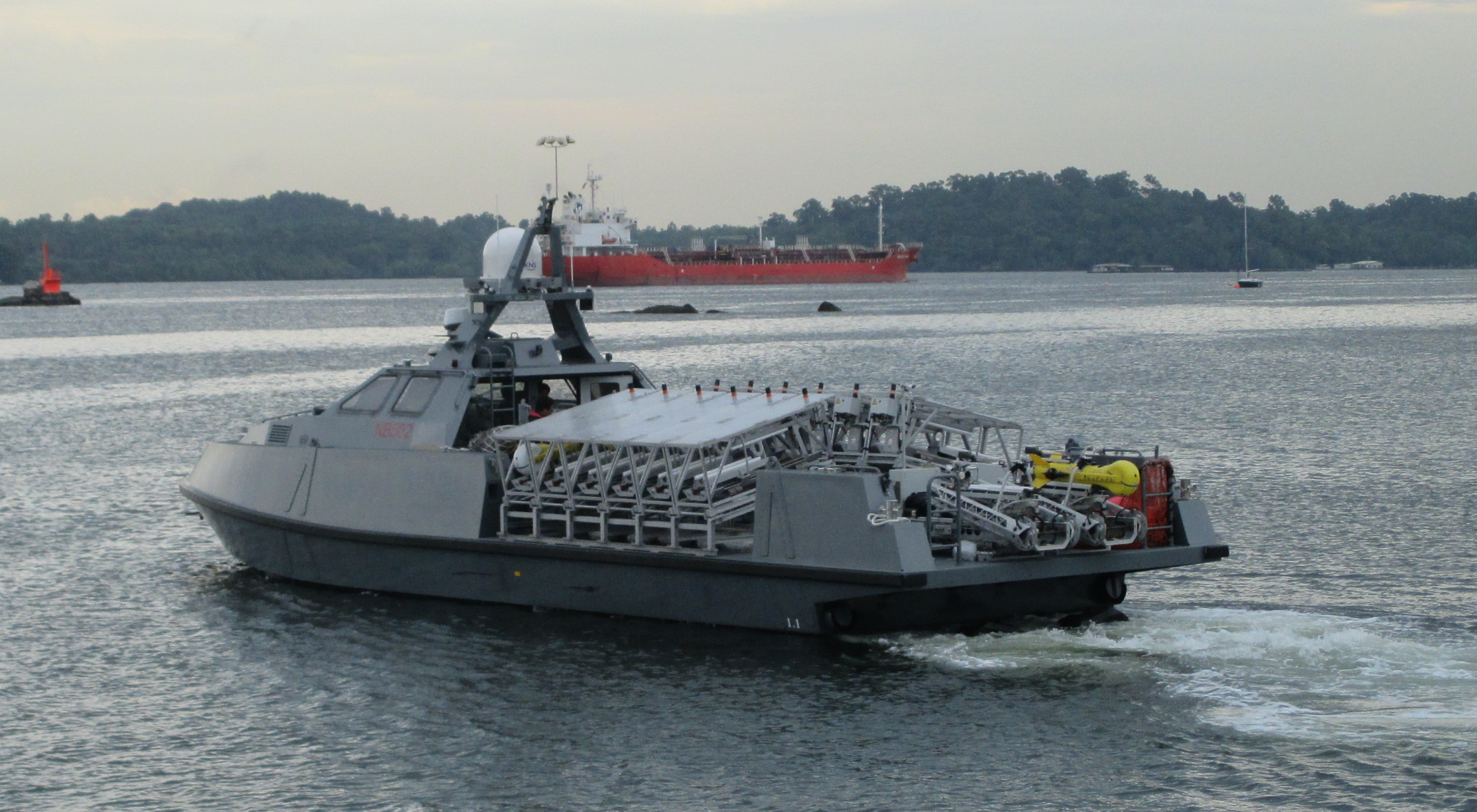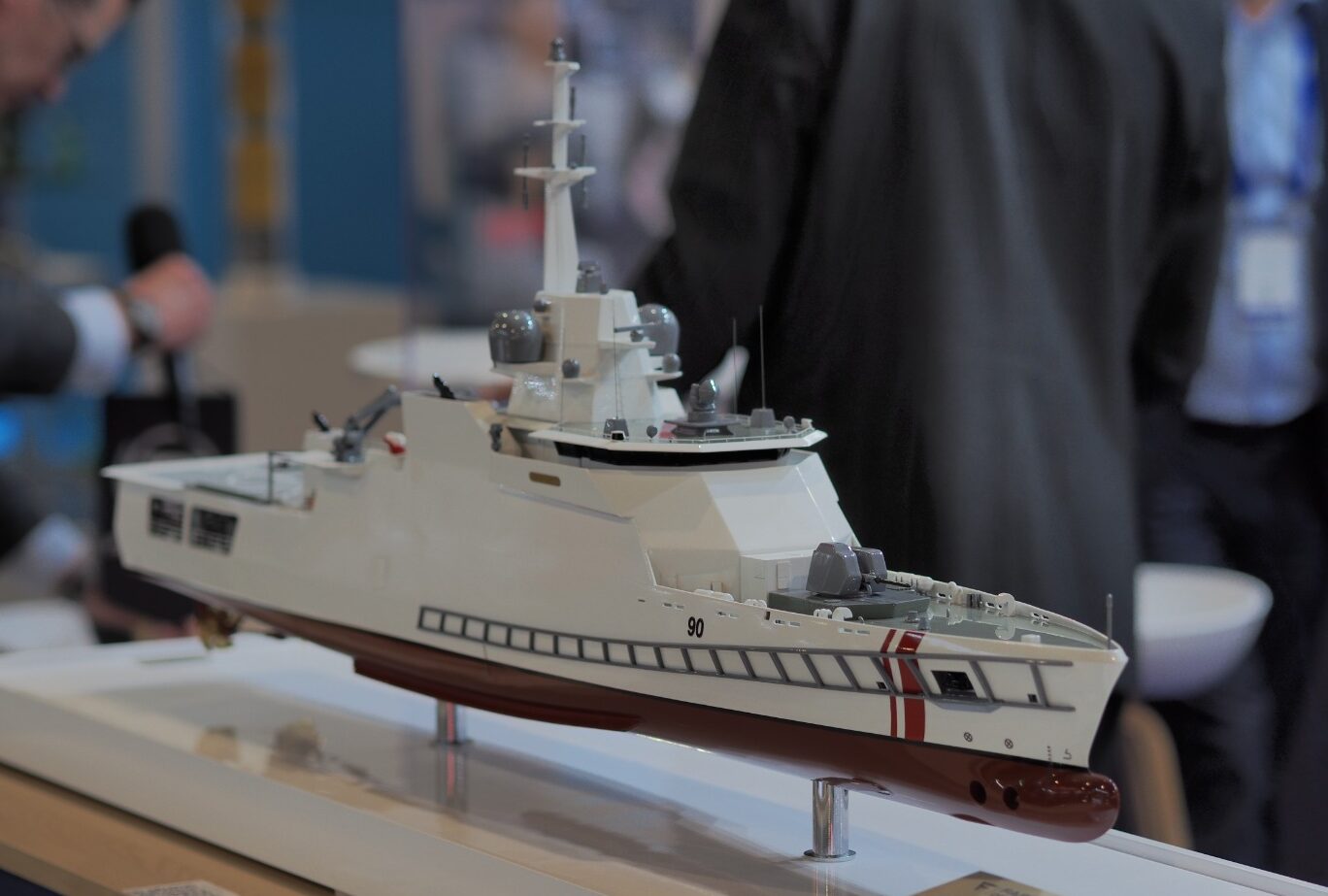As I mentioned in my previous article, the biennial IMDEX 2025, held at Singapore's Changi Naval Base, had announcements and news on systems related to the Republic of Singapore Navy (RSN).
New Mine-Countermeasure Capabilities
 |
| Image: DSO National Laboratories: MCM USV with K-Ster expendable mine disposal system. --- |
First up, Singapore's Bedok-class MCM (a variant of the Swedish Landsort-class) will be replaced by a mine countermeasure suite from 2027 that includes Unmanned Surface Vessels (USV) and Autonomous Underwater Vehicles (AUV). The four ships of the Bedok class first entered service in 1995.
The RSN has operated USVs since 2005, deploying an IAI Protector USV to the Gulf of Aden for force protection. Singapore’s DSO National Laboratories and ST Engineering then began the Venus USV development program with autonomous Collision Detection Collision Avoidance (CDCA) to navigate Singapore’s crowded littoral conditions. From the initial 9 metre Venus 9, DSO and ST Engineering developed the 16.9 metre MARSEC USV for both maritime security and mine countermeasures.
Thales announced at IMDEX 2025 that the RSN has purchased the Thales Pathfinder mine warfare system, which features a Towed Synthetic Aperture Sonar (T-SAS), while Exail also disclosed recently that Singapore has purchased multiple robotic Mine Identification and Disposal Systems (MIDS) including the K-STER expendable underwater drone, SEASCAN mine identification Remotely Piloted Vehicle (ROV), and the UMISOFT command and control (C2) suite.
Fleetwide adoption of STRALES
| Image: EUNAVFOR Operation ASPIDES: Italian ship (ITS) Virginio Fasan engaging UAV with OTO 76mm/62 STRALES gun on April 29 2024, in the Red Sea. --- |
Since IMDEX 2023, we’ve known that the MRCV weapons fit will include MBDA VL MICA NG and ASTER 30 B1 NT SAMs, ST/IAI Blue Spear ASMs and the Leonardo OTO 76mm/62 Super Rapid STRALES.
But during a recent written reply to questions from Janes Defence, Singapore’s Chief of Navy Rear Admiral Sean Wat confirmed that the RSN will adopt STRALES throughout its fleet, as the system has “proven to be effective against moving air and surface targets” - likely a reference to the STRALES-equipped Italian Navy FREMM frigate ITS Virginio Fasan, which shot down a hostile UAV on the 29th of April 2024 during a merchant escort operation in the Red Sea.
STRALES is an upgrade kit that enables the OTO 76/62 naval gun to fire the DART (Driven Ammunition Reduced Time of flight) guided munition, allowing the gun to engage fast and small airborne/surface targets rapidly out to 15km.
The RSN first adopted the OTO Melara 76/62 SR gun in 1990 with the Victory-class missile corvettes, and it is currently the standard main gun for all RSN surface combatants, except the Bedok-class MCMs. As STRALES is available as an upgrade kit to in-service guns, I expect the Formidable-class frigates to upgrade to STRALES as they are now undergoing their Mid-Life Update (MLU), and the Independence-class LMV when they undergo scheduled maintenance.
Type 218SG Follow-On Order Signed
I have previously speculated that Singapore would order a third tranche (5th and 6th) Invincible-class (Type 218SG) submarines from thyssenkrupp Marine Systems (TKMS), and this confirmed at IMDEX 2025 with a contract signing ceremony.
TKMS now has a full order book of around €16 billion, with up to 20 submarines on order - 12 to 15 Type 212CD for the German and Royal Norwegian Navies, 3 Dakar-class boats for the Israeli Navy, and 2 Invincible-class boats for Singapore, which are scheduled for delivery from 2034.
No details of this contract were revealed, but as this order comes 12 years after the initial contract for the first two boats, we can expect some modifications to the design specifications, such as the inclusion of a VLS module.
With the first 4 Invincible-class submarines entering RSN service by 2028, this would expand Singapore's operational submarine fleet to 6, alongside the 2 Archer-class boats, though the 'from 2034' delivery date of the third tranche is slightly concerning, as this means that the Archers will need to serve 22 years in the RSN, in addition to the 25 years they served in the Royal Swedish Navy as HSwMS Vastergotland and HSwMS Halsingland.
MRCV model displayed at IMDEX 2025
 |
| Image: Image capture from Naval News video. --- |
Janes Defence notes that Singapore’s ST Engineering had a model of the MRCV as the centrepiece of their booth, and the model highlighted the area below the flight deck where two large PALFINGER Marine PQBS-SR Slipway Systems for Launch and Recovery (LARS) of RHIBs and USVs. Janes also highlighted the model’s bulbous bow, which indicates a hull-mounted sonar.
Integrating a towed sonar array may not be possible because of the LARS, although this does not preclude an USV deployed system such as the Thales Australia BlueSentry Remote Active Sonar System (RASS).
Note that PALFINGER has not disclosed the Safe Working Load capacity of the PQBS-SR slipway system for the MRCV, but we could imply that PALFINGER stated “large” to handle the MARSEC USV, which are 16.9 metres in length and displace 30 tonnes.
Both the Independence-class LMV and the upcoming Fassmer Offshore Patrol Vessel (OPV) feature dual PALFINGER Marine Slipway Systems, with the LMVs able to carry vessels up to 11 metres in length.
 |
| Image: PALFINGER Marine. --- |
Navalnews has also confirmed that the MRCV will be 150 metres long, with a beam of 21.04 metres and with a full load displacement of 8,400 tonnes, and have accommodations for up to 160 personnel.
The MRCVs will use Combined Diesel and Diesel (CODAD) by M.A.N. with an Integrated Full Electric Propulsion (IFEP) system with electric motors by GE Vernova. This will enable a top speed of 24 knots.
The model displayed at IMDEX 2025 showed a 4x8 VLS system behind the main gun, and a large enclosed space between the primary superstructure and the funnels/helicopter hanger, which could be the location for the Blue Spear Anti-Ship missile system. A similar ‘missile/flex deck’ on the Formidable-class enables these frigates to carry up the 24 Harpoon SSMs.
In addition to the MARSEC USV, unmanned systems for the MRCV may also include:
ST Engineering Veloce 60 VTOL UAV (with engines developed by Orbital UAV)
TKMS MEKO S-X ASW Drone
ST Engineering Mercury AUV
Fassmer OPV90 MK II for Singapore?
 |
| Image: hartpunkt.de --- |
At IMDEX 2025, Fassmer Defence revealed its latest Offshore Patrol Vessel design, the OPV90 MK II. Fassmer has a 90m Offshore Patrol Vessel in its product catalogue for a few years, but the model of the OPV90 MK II is significantly different from the parent design, featuring a detailed weapons and equipment fit that’s not usually seen in a ‘marketing’ model - such as communication systems, OTO 76/62 STRALES main gun, Saab Sea Giraffe 1x AESA radar, secondary RCW weapons fit and an equipment bay for four 20-foot-ISO containers, plus integrated fenders for alongside operations - a feature that is also found on the RSN's Sentinal-class Maritime Security and Response Vessels (MRSV).
Fassmer confirmed to NavalNews that the OPV90 Mk II is in production, and since we know Fassmer has laid the keels for the first two of four OPVs that the RSN ordered, it's quite obvious that the OPV90 Mk II will fly the Singapore naval ensign.
IMDEX 2025 was held May 6 to May 8, 2025 and was judged a smashing success.

7 comments:
Hi Shawn
An excellent post.
I'm assuming Singapore opted for 2 additional Invincible-class subs - making 6 in future - to boost availability. This may make 3 available for operations in times of tension rather then just 2.
Also it may make it easier for one Invincible to be detached to tail a Chinese SSK passing through the Malacca Strait - then say 1,000 kms into the Indian Ocean. After that 1,000 kms India may take over the SSK tailing task.
Cheers Pete
Hi Pete,
Naval unit lots of 3 make a lot of sense if we apply the traditional 'formula' of 'one on ops, one in training/work-up and one in maintenance', but this sometimes does not apply to the RSN, which now has significant facilities on or nearby (within two hours sail) for ship servicing and maintenance, as well as a short length of operational deployment - rarely over three months, compared to six months in the USN/RN/RAN.
In terms of the RSN submarine fleet, it's stayed at 2002, first with the four Challenger class boats, then in 2015 two were retired and replaced by the Archer class. So the 50% growth in submarine units in 2028 (2 Archer, 4 Invincible) will be a significant event for the RSN, as it allows for concurrent deployment of submarines with significant range.
The Strait of Malacca is not submarine-friendly, as it has a 25-metre depth limit, so any submarine passing through the Strait has to do so on the surface. If the RSN needed to tail the boats of other navies, I would expect this to occur to the north of the Malacca Strait, where it meets the Andaman Sea, or East in the Natuna Sea.
Hi Shawn
Interesting 6 SSKs is the golden number for Australia and Singapore, but for far different geographies.
If RSN subs tail Chinese SSKs this may indeed end NW of the Malacca Strait in the Andaman Sea or between some Nicobar islands. Then tailing may be handed over to the Indian Navy. Covering such activities I would guess a comprehensive agreement exists between Singapore and India.
Chinese laid sensors around the Andaman and Nicobar islands may be regularly swept/removed by the Indian Navy.
In contrast there may be no large navy (be it western or Indonesian) that has the resources to sweep Chinese laid sensors in the South China Sea extending down to the Natuna islands.
Cheers Pete
Hey Pete,
Reckon the Indonesians know fully well the challenges the country faces with securing its territorial waters, especially the Sunda, Bali, Lombok and Makassar Straits.
The main issue they face is about putting aside their political vested interests. The Indonesian naval industry can sustain a build program for OPVs and patrol boats, and PT PAL is now able to build LSTs, Type-31 frigates and Scorpene Evo submarines (well, whenever they stop dicking over the contract). What the do need is better underwater surveillance, whether it’s maritime drones, SOSUS stations or an integrated C2 feature (seems they’ve ask Singapore for help on the latter) https://www.navalnews.com/naval-news/2025/04/indonesian-navy-seeks-sosus-like-systems-to-detect-foreign-submarines/
Malaysia, Singapore and Vietnam have come to an agreement on a shared power grid with renewable energy from Sarawak, and this will make subsea monitoring critical in the Natuna Sea and Gulf of Thailand.
https://www.straitstimes.com/asia/se-asia/pm-anwar-bullish-on-regional-power-grid-myanmar-conflict-as-malaysia-hosts-asean-summit
I don’t expect Indonesia to have any objections to these cables, and you can expect that there will be a few backroom deals about the security ramifications.
Hi Shawn at 5/26/2025 7:20 PM
It would be interesting to gauge minesweeping and SOSUS detection and removal activities in the Indo-Pacific - though I assume thats classified.
It is to the opponents of Indonesia's advantage if Indonesia buys subs from multiple countries: USSR and Germany in the past, SK more recently, Russia a prospect and France more definite. Gifts to opponents include the extra costs of buying just a few submarines, spares, weapons and training complications.
Indonesia also buys air force craft in penny packets. Might commissions be the motivation?
Cheers Pete
Hi again Shawn at 5/26/2025 7:28 PM
Are, Sarawak being a "East Malaysian state that is planning to nearly triple its renewable energy capacity to 15 gigawatts (GW) by 2035." That is a lot of electricity! https://www.straitstimes.com/asia/se-asia/pm-anwar-bullish-on-regional-power-grid-myanmar-conflict-as-malaysia-hosts-asean-summit
With "a regionwide grid would require an investment of US$764 billion" getting the funds from China might be best given sinking US political and economic reliability.
The Malaysian Navy's many corvettes and patrol boats (shallow draft) might be most economical for subsea monitoring in the Natuna Sea and shallow Gulf of Thailand.
Cheers Pete
Post a Comment